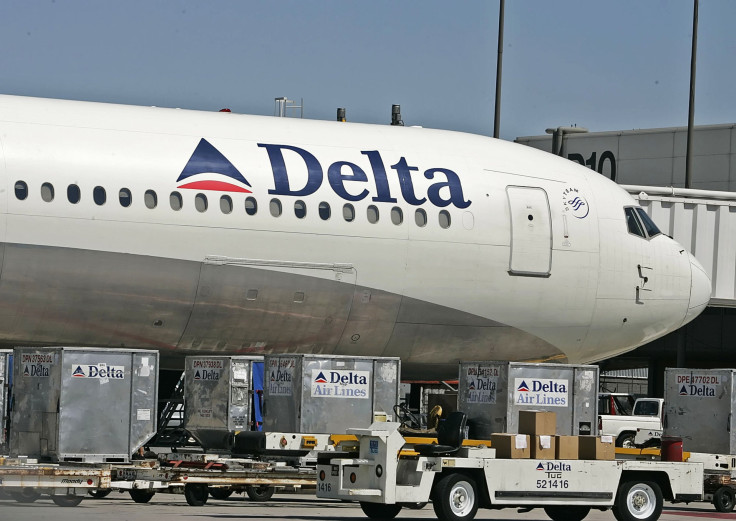Delta Air Lines Delivers Q1 Earnings Beat And Solid Outlook

Delta Air Lines (NYSE:DAL) stock soared 12% last week after the company raised its outlook for the first quarter and announced that it had extended its lucrative credit card partnership with American Express (NYSE:AXP) all the way to 2029.
Delta Air Lines stock looks like it can keep rising in the coming months, as the company posted Q1 earnings on Wednesday that exceeded even its updated forecast. The No. 2 airline by revenue also expects to post strong earnings growth in the second quarter. Let's take a closer look at Delta's first-quarter results and outlook for the rest of the year.
Revenue growth surpasses expectations
Delta's total revenue -- adjusted for sales of petroleum products by its wholly owned refinery -- jumped 7.5% to $10.4 billion last quarter. Revenue per available seat mile (RASM) rose 2.4%, ahead of the 2% increase that management had projected in last week's guidance update.
This solid RASM gain was driven by higher premium seat revenue and a huge surge in revenue related to Delta's loyalty program. Indeed, while total capacity increased 5% year over year, main cabin revenue inched up just 2% (indicating a unit revenue decline). However, premium product revenue rose 8%, and revenue from travel-related services and tickets purchased using loyalty points jumped 16% and 12%, respectively. Meanwhile, non-ticket revenue from the loyalty program skyrocketed 37% year over year to $474 million.
The sharp uptick in loyalty-related revenue was no surprise. Delta has seen strong growth there in recent years, driven primarily by its successful partnership with American Express. Between 2012 and 2018, spending on Delta co-branded AmEx cards more than doubled, reaching $92.4 billion. That makes Delta Air Lines an indispensable partner for American Express, which is why the credit card giant appears to have offered Delta improved terms -- driving 1 percentage point of Delta's Q1 RASM growth -- to secure a long-term renewal of their relationship.
Geographically, the domestic market remained the strongest region, with a 0.9% passenger unit revenue increase despite 5.9% capacity growth. Passenger unit revenue fell in the trans-Atlantic and trans-Pacific markets. And while passenger unit revenue rose 2.4% in Latin America, Delta had to put the brakes on its growth there to achieve that result, increasing capacity just 0.5%.
Cost performance was strong, too
Delta Air Lines' cost performance in the first quarter also surpassed management's expectations. Adjusted nonfuel unit costs ticked down 0.2% year over year in the first quarter, whereas Delta had initially forecast a 1% to 2% increase. Even its guidance update issued last week had estimated that nonfuel unit costs would rise 0% to 0.5% year over year.
The airline did suffer a slight uptick in its average fuel price to $2.05 per gallon last quarter, compared to $2.01 per gallon a year earlier, even though market fuel prices declined. The cause was a $44 million loss at Delta's refinery, compared to a $34 million profit in Q1 2018. Delta Air Lines more or less offset this increase in its average fuel price through a roughly 2.1% improvement in its fuel efficiency last quarter.
The net result was that adjusted earnings per share soared 28% year over year to $0.96. That exceeded the high end of Delta's updated guidance, which called for adjusted EPS between $0.85 and $0.95 for the first quarter. It also beat the average analyst estimate of $0.89.
Double-digit earnings growth will continue
Delta Air Lines expects the good times to continue in the second quarter and beyond. For Q2, the carrier projected a solid 1.5% to 3.5% RASM increase. Nonfuel unit costs are expected to rise 1% to 2% year over year, while Delta estimates that its average fuel price will come in between $2.10 per gallon and $2.20 per gallon, compared to $2.17 per gallon a year ago.
All of this adds up to a forecast that Delta will post an impressive 14% to 16% pre-tax margin this quarter. Management expects adjusted EPS to reach a range of $2.05 to $2.35, which would represent year-over-year growth of 16% to 33%.
Looking further ahead, Delta Air Lines boosted its full-year revenue outlook. It now expects to increase its revenue 5% to 7% in 2019, compared to the 4% to 6% growth projection that management shared at Delta's investor day last December. CEO Ed Bastian also said that he had increased confidence in the company's ability to return to margin expansion and achieve double-digit EPS growth for 2019 as a whole.
Delta Air Lines stock still trades for less than nine times the company's projected 2019 earnings, which hardly seems consistent with its impressive growth trajectory. If Delta keeps posting strong results like this in the next few quarters, the airline giant's shares could move much higher.
This article originally appeared in the Motley Fool.
Adam Levine-Weinberg owns shares of Delta Air Lines. The Motley Fool owns shares of and recommends Delta Air Lines. The Motley Fool has a disclosure policy.





















